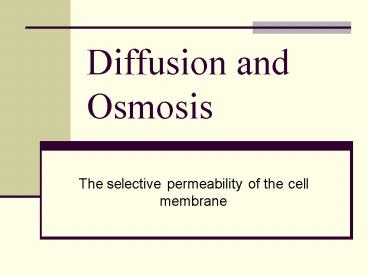Diffusion and Osmosis - PowerPoint PPT Presentation
1 / 15
Title:
Diffusion and Osmosis
Description:
A hypotonic solution has a LOWER concentration of solutes ... An isotonic solution is a solution that has a concentration of solutes equal to its environment ... – PowerPoint PPT presentation
Number of Views:118
Avg rating:3.0/5.0
Title: Diffusion and Osmosis
1
Diffusion and Osmosis
- The selective permeability of the cell membrane
2
The movement of molecules
- Heat causes the random motion of all molecules
- This movement cannot be seen directly, but its
effects can be seen under a microscope - The movement of particles resulting from
collisions with other particles is called
Brownian movement
3
Solutions
- A solution is a homogenous mixture in liquid form
- Usually we think of solutions as some substance
(the solute) dissolved in water (the solvent) - Almost all biological systems are suspended in
water
4
How do solutions form?
- Solutions form through the process of diffusion
- Diffusion is the net movement of substances from
areas of high concentration, heat, or pressure,
to areas of low concentration, heat, or pressure - In most biological systems, heat and pressure are
constant (most of the time), so we will discuss
movement along a concentration gradient
5
The Formation of a Sugar-Water Solution
6
Diffusion
- The rate of diffusion is affected by the
steepness of the gradient - The rate is also affected by several
characteristics of the molecule, including size,
polarity, and solubility - Which do you think will diffuse faster? A
substance with a HIGH molecular weight, or a
substance with a LOW molecular weight? Why?
7
Diffusion and Membranes
- Cells are surrounded by membranes composed of a
phospholipid bilayer - The nature of this membrane allows some molecules
to pass more easily than others, making it
selective and differentially permeable - Small, non-polar molecules can pass easily
through the membrane, while large, polar
molecules cannot
8
Diffusion and Membranes
- However, there are some openings in the membrane
(i.e. protein channels, ion channels, etc.) - These channels allow polar molecules to cross the
membrane, but are still selective on the basis of
size and shape - In this lab, we can simulate the membrane and its
differential permeability (based on size) with
dialysis tubing
9
Differential Permeability
10
Dialysis
- Dialysis is the separation of dissolved
substances by means of their unequal diffusion
through a differentially permeable membrane - Particles below a certain size can pass through,
while those above a certain size cannot - Dialysis tubing DOES NOT select based on charge
and solubility like cells do, ONLY size
11
Osmosis
- Osmosis is the diffusion of water across a
differentially permeable membrane (Diffusion
refers to ANY substance, Osmosis refers ONLY to
water) - We can predict the net movement of water based on
concentration gradients relative to the
environment - We can describe solutions in one of three ways
(relative to their environment) hypotonic,
isotonic, or hypertonic
12
Osmosis
- A hypotonic solution has a LOWER concentration of
solutes - A hypertonic solution has a HIGHER concentration
of solutes - An isotonic solution is a solution that has a
concentration of solutes equal to its environment - So how does this affect cells?
13
Osmosis
- The net movement of water is always FROM a
hypotonic solution TO a hypertonic solution - If you look at it as simply a diffusion of water,
the net movement is always from the higher
concentration of water (the hypotonic solution)
to the lower concentration of water (the
hypertonic solution) - There is NO NET MOVEMENT in isotonic solutions
14
Effects of Osmosis
15
Effects of Osmosis































